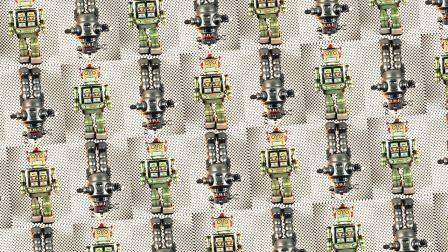find out how to steer clear of Being replaced by using A robotic
the fear of job loss due to automation is no longer relegated to simply physical-labor manufacturing jobs and moderately simple transaction-based, consumer-service employees (i.e., bank tellers, grocery store clerks, and shuttle retailers). firms are more and more adopting sophisticated “cognitive” technologies throughout a new swath of knowledge-employee jobs in fields comparable to finance, well being care, and insurance.
however, determining what this increased adoption price actually way appears elusive. special reports and articles from revered economists and IT mavens present divergent and ambiguous views concerning whether or no longer automation will displace millions of data workers.
In a up to date ny times magazine article, “The Robots Are Coming for Wall street,” executives from Goldman Sachs and Barclays bemoaned and praised a growing pattern of economic analysts becoming displaced by smarter, big information-oriented instrument. alternatively, a contemporary Huffington post piece, “We may well be All wrong About Robots Taking Our Jobs,”, highlighted the positive views of MIT Professors Erik Brynjolfsson and Andrew McAfee, co-authors of The 2d desktop Age, saying that the expansion of sensible machines and automation catalyzes the emergence of recent and exciting data employee jobs.
not My Job
some other view put forth within a March Pew analysis file, “Public Predictions for the future of team of workers Automation,” cited that “two-thirds of usa citizens expect that robots and computers will do a lot of the work currently carried out with the aid of people in 50 years, but most staff are expecting that their own jobs will exist of their current types in five many years.”
“Labor economists look at dislocation on a very large scale, and there are some economists who say that everything works out in the long run, so don’t fear. Then there are others who say that this time it is different, and we must be very worried,” says Julia Kirby, co-author with Thomas H. Davenport, of simplest humans want apply: Winners and Losers within the Age of smart Machines, to be published in may via Harper industry.
“None of these people supply the individual any kind of feel that they are able to be doing one thing to shape their own fate,” Kirby provides. “that’s the roughly vacuum we saw in the entire discourse about this.”
finding out find out how to Adapt
If historical past is our guide, job displacement from sensible machines jobs merely signifies that knowledge workers must learn how to adapt, just like how civilization efficiently transitioned from an agricultural to an industrial society. they need to discover ways to supplement and make stronger their talents. in brief, knowledge staff need to turn out to be augmenters, a situation wherein “humans and computer systems mix their strengths to succeed in more outcomes than both may on my own.” that is the key message that comes out of Davenport’s and Kirby’s upcoming guide.
“We determined that essentially the most accountable thing to do was once to focal point on what individuals can do to extend the possibility that they are going to maintain a job,” Davenport says, including that “no one truly knows precisely what number of jobs are going to be lost via automation. we expect it is most certainly smaller than what many people are saying.”
still, “there are very real downsides to the brand new wave of good machines,” the authors notice. for example, Allstate used to be an early adopter of automation for insurance underwriting tasks within the mid-1990s. during that course of, two-thirds of 1,000 Allstate knowledge staff were in a position to maneuver upstream to better-skilled jobs in portfolio administration, enterprise possibility management, and agent relationships. the rest one-third didn’t have the appropriate talents to move upstream and in some way lost their jobs.
5 Steps to stay relevant And Employed
whereas the Allstate example is a sobering representation of an industry-vast, data-worker, job-loss state of affairs, there’s an upside attainable concerning the adoption of such advancing know-how. It’s the promise of augmentation, Davenport and Kirby argue. Augmentation will also be pushed thru 5 key methods data employees will have to pursue so as to add worth to machines and have machines add worth to them:
- Stepping up
- Stepping apart
- Stepping in
- Stepping narrowly
- Stepping forward
individuals who tackle these strategies have to be prepared “to burn the midnight oil to strengthen their very own abilities, and either make friends with sensible machines or give you the chance to do things they can’t do. Complacency isn’t an option. but despondency isn’t required either.”
people who step up make excessive-degree choices. they are senior executives who decide where cognitive technologies need to be utilized, and the way new programs match into the industry group overall. they are the few at the high of the augmentation pyramid, the authors write. “they’re finding out what sensible people do, what sensible machines do, and the way they work collectively.”
folks that step apart keep in mind the best way to let machines do the work that machines are perfect at, equivalent to computational duties, while “concurrently selecting to base your individual livelihood on types of worth that machines just cannot ship.” Stepping aside method specializing in learn how to reinforce our so-referred to as “a couple of intelligences.” this is the gap the place “logical computation can’t present optimized answers,” comparable to working towards emotional intelligence and even utilizing our potential to resolve problems through irrational approach.
Stepping in approach understanding how you can make machines productive. These are the people who comprehend the best way to join technical and industry environments. “Their position involves both picking eventualities for which the computer isn’t well applicable, and helping it to deliver even larger productivity advances over time,” the authors note.
people who step narrowly are those who “hyperspecialize.” They take the time to observe their passions into work that cannot be automatic. they’ve a clear experience of course and take the vital steps to become experts in their field. It approach “pushing ever deeper into a topic, with all of the pressure of previous achievement helping you, and studying the subsequent thing about it through the kind of centered consideration and experimentation that machines can’t manage,” Davenport and Kirby explain.
people who step forward are technically educated and entrepreneurial folks who actually build the good machines. individuals who step forward will have the brightest future within the age of automation. they are programmers, data scientists, researchers, product managers, marketers, consultants, and extra. they’re “particularly adept at learning new talents and updating their resumes to replicate their new skills,” Davenport and Kirby counsel. “Their reward shall be a valuable one: Working in an exhilarating business, and drawing a just right paycheck from it over many years.”
(13)













